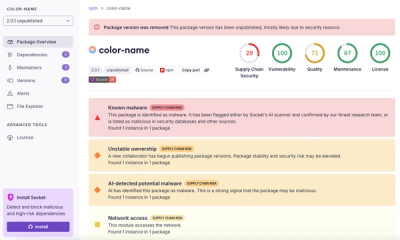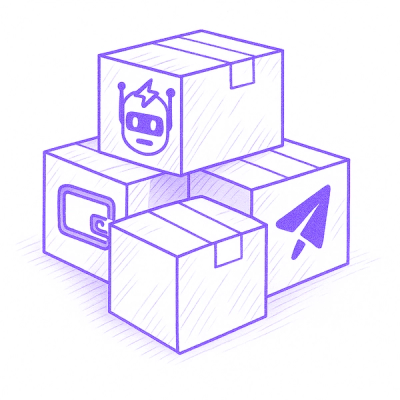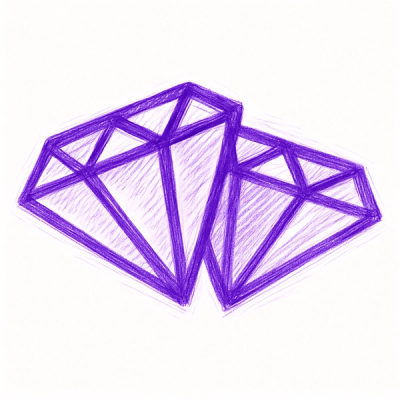
Research
/Security News
npm Author Qix Compromised via Phishing Email in Major Supply Chain Attack
npm author Qix’s account was compromised, with malicious versions of popular packages like chalk-template, color-convert, and strip-ansi published.
keras-unet-collection
Advanced tools
The Tensorflow, Keras implementation of U-net, V-net, U-net++, UNET 3+, Attention U-net, R2U-net, ResUnet-a, U^2-Net, TransUNET, and Swin-UNET with optional ImageNet-trained backbones.
The tensorflow.keras implementation of U-net, V-net, U-net++, UNET 3+, Attention U-net, R2U-net, ResUnet-a, U^2-Net, TransUNET, and Swin-UNET with optional ImageNet-trained backbones.
keras_unet_collection.models contains functions that configure keras models with hyper-parameter options.
keras_unet_collection.models | Name | Reference |
|---|---|---|
unet_2d | U-net | Ronneberger et al. (2015) |
vnet_2d | V-net (modified for 2-d inputs) | Milletari et al. (2016) |
unet_plus_2d | U-net++ | Zhou et al. (2018) |
r2_unet_2d | R2U-Net | Alom et al. (2018) |
att_unet_2d | Attention U-net | Oktay et al. (2018) |
resunet_a_2d | ResUnet-a | Diakogiannis et al. (2020) |
u2net_2d | U^2-Net | Qin et al. (2020) |
unet_3plus_2d | UNET 3+ | Huang et al. (2020) |
transunet_2d | TransUNET | Chen et al. (2021) |
swin_unet_2d | Swin-UNET | Hu et al. (2021) |
Note: the two Transformer models are incompatible with Numpy 1.20; NumPy 1.19.5 is recommended.
keras_unet_collection.base contains functions that build the base architecture (i.e., without model heads) of Unet variants for model customization and debugging.
keras_unet_collection.base | Notes |
|---|---|
unet_2d_base, vnet_2d_base, unet_plus_2d_base, unet_3plus_2d_base, att_unet_2d_base, r2_unet_2d_base, resunet_a_2d_base, u2net_2d_base, transunet_2d_base, swin_unet_2d_base | Functions that accept an input tensor and hyper-parameters of the corresponded model, and produce output tensors of the base architecture. |
keras_unet_collection.activations and keras_unet_collection.losses provide additional activation layers and loss functions.
keras_unet_collection.activations | Name | Reference |
|---|---|---|
GELU | Gaussian Error Linear Units (GELU) | Hendrycks et al. (2016) |
Snake | Snake activation | Liu et al. (2020) |
keras_unet_collection.losses | Name | Reference |
|---|---|---|
dice | Dice loss | Sudre et al. (2017) |
tversky | Tversky loss | Hashemi et al. (2018) |
focal_tversky | Focal Tversky loss | Abraham et al. (2019) |
ms_ssim | Multi-scale Structural Similarity Index loss | Wang et al. (2003) |
iou_seg | Intersection over Union (IoU) loss for segmentation | Rahman and Wang (2016) |
iou_box | (Generalized) IoU loss for object detection | Rezatofighi et al. (2019) |
triplet_1d | Semi-hard triplet loss (experimental) | |
crps2d_tf | CRPS loss (experimental) |
pip install keras-unet-collection
from keras_unet_collection import models
# e.g. models.unet_2d(...)
Note: Currently supported backbone models are: VGG[16,19], ResNet[50,101,152], ResNet[50,101,152]V2, DenseNet[121,169,201], and EfficientNetB[0-7]. See Keras Applications for details.
Note: Neural networks produced by this package may contain customized layers that are not part of the Tensorflow. It is reommended to save and load model weights.
Jupyter notebooks are provided as examples:
Attention U-net with VGG16 backbone [link].
UNET 3+ with deep supervision, classification-guided module, and hybrid loss [link].
Vision-Transformer-based examples are in progress, and available at keras-vision-transformer
TensorFlow 2.5.0, Keras 2.5.0, Numpy 1.19.5.
(Optional for examples) Pillow, matplotlib, etc.
U-net is a convolutional neural network with encoder-decoder architecture and skip-connections, loosely defined under the concept of "fully convolutional networks." U-net was originally proposed for the semantic segmentation of medical images and is modified for solving a wider range of gridded learning problems.
U-net and many of its variants take three or four-dimensional tensors as inputs and produce outputs of the same shape. One technical highlight of these models is the skip-connections from downsampling to upsampling layers, which benefit the reconstruction of high-resolution, gridded outputs.
Yingkai (Kyle) Sha <yingkai@eoas.ubc.ca> <yingkaisha@gmail.com>
@misc{keras-unet-collection,
author = {Sha, Yingkai},
title = {Keras-unet-collection},
year = {2021},
publisher = {GitHub},
journal = {GitHub repository},
howpublished = {\url{https://github.com/yingkaisha/keras-unet-collection}},
doi = {10.5281/zenodo.5449801}
}
FAQs
The Tensorflow, Keras implementation of U-net, V-net, U-net++, UNET 3+, Attention U-net, R2U-net, ResUnet-a, U^2-Net, TransUNET, and Swin-UNET with optional ImageNet-trained backbones.
We found that keras-unet-collection demonstrated a healthy version release cadence and project activity because the last version was released less than a year ago. It has 1 open source maintainer collaborating on the project.
Did you know?

Socket for GitHub automatically highlights issues in each pull request and monitors the health of all your open source dependencies. Discover the contents of your packages and block harmful activity before you install or update your dependencies.

Research
/Security News
npm author Qix’s account was compromised, with malicious versions of popular packages like chalk-template, color-convert, and strip-ansi published.

Research
Four npm packages disguised as cryptographic tools steal developer credentials and send them to attacker-controlled Telegram infrastructure.

Security News
Ruby maintainers from Bundler and rbenv teams are building rv to bring Python uv's speed and unified tooling approach to Ruby development.